Do you have a question about the Vespa GTV 250 i.e. and is the answer not in the manual?
Overview of the scooter's dashboard layout and indicators, including the instrument panel.
How to set the clock and manage trip/total mileage readings.
Functions of the ignition switch and steering lock mechanism.
Operation of turn indicators and light switches for visibility.
Explanation of horn, light, and starter buttons.
Engine shut-off function and introduction to the anti-theft system.
Information on keys, indicator light, and system operation.
Procedure to add or reprogram immobilizer keys.
How to open the saddle to access the fuel tank.
Upholstery details and how to open the saddle for storage.
Location of chassis and engine ID for official records.
Instructions for opening the rear top box.
Essential safety and functional checks before riding.
Correct steps and warnings for refueling the scooter with petrol.
Maintaining correct tyre pressure for safety and longevity.
Adjusting rear suspension preload for rider and load.
Recommended procedures for the first 1000 km.
Step-by-step guide to start the engine correctly.
Advice for dealing with difficult engine startup.
How to safely turn off the engine.
Instructions for parking the scooter on its stands.
Explanation of the CVT system and clutch.
Essential tips and precautions for safe daily operation.
Information on the rear rack and load limits.
Procedure for verifying engine oil quantity.
How to add engine oil when necessary.
Understanding the function and meaning of the oil pressure indicator.
Recommended intervals for oil and filter replacement.
Procedure for checking and maintaining the hub oil level.
Regular inspection of tyres for wear and inflation.
Steps for spark plug removal and installation.
Cleaning and oiling the air filter element.
Checking the engine coolant level.
Procedure for checking front and rear brake fluid.
Information on battery characteristics and general maintenance.
Correctly fitting and connecting a new battery.
Tips for maintaining battery health during storage.
Identifying fuse locations and their purpose.
Replacing bulbs in the headlight and position lights.
Correctly aiming the headlight beam.
Replacing bulbs for turn signals and tail lights.
Adjusting mirrors for optimal rear visibility.
Operation, wear compensation, and checks for disc brakes.
Dealing with tyre punctures and temporary repair options.
Recommended methods for washing the scooter.
Specifications for overall length, width, and height.
Details on engine type, capacity, bore, stroke, and ignition.
Technical details of suspension, brakes, wheels, and chassis.
Kerb weight, maximum load, and capacities for fluids.
Description of the tools provided with the scooter.
Critical safety advice when fitting accessories or carrying loads.
Overview of the scooter's dashboard layout and indicators, including the instrument panel.
How to set the clock and manage trip/total mileage readings.
Functions of the ignition switch and steering lock mechanism.
Operation of turn indicators and light switches for visibility.
Explanation of horn, light, and starter buttons.
Engine shut-off function and introduction to the anti-theft system.
Information on keys, indicator light, and system operation.
Procedure to add or reprogram immobilizer keys.
How to open the saddle to access the fuel tank.
Upholstery details and how to open the saddle for storage.
Location of chassis and engine ID for official records.
Instructions for opening the rear top box.
Essential safety and functional checks before riding.
Correct steps and warnings for refueling the scooter with petrol.
Maintaining correct tyre pressure for safety and longevity.
Adjusting rear suspension preload for rider and load.
Recommended procedures for the first 1000 km.
Step-by-step guide to start the engine correctly.
Advice for dealing with difficult engine startup.
How to safely turn off the engine.
Instructions for parking the scooter on its stands.
Explanation of the CVT system and clutch.
Essential tips and precautions for safe daily operation.
Information on the rear rack and load limits.
Procedure for verifying engine oil quantity.
How to add engine oil when necessary.
Understanding the function and meaning of the oil pressure indicator.
Recommended intervals for oil and filter replacement.
Procedure for checking and maintaining the hub oil level.
Regular inspection of tyres for wear and inflation.
Steps for spark plug removal and installation.
Cleaning and oiling the air filter element.
Checking the engine coolant level.
Procedure for checking front and rear brake fluid.
Information on battery characteristics and general maintenance.
Correctly fitting and connecting a new battery.
Tips for maintaining battery health during storage.
Identifying fuse locations and their purpose.
Replacing bulbs in the headlight and position lights.
Correctly aiming the headlight beam.
Replacing bulbs for turn signals and tail lights.
Adjusting mirrors for optimal rear visibility.
Operation, wear compensation, and checks for disc brakes.
Dealing with tyre punctures and temporary repair options.
Recommended methods for washing the scooter.
Specifications for overall length, width, and height.
Details on engine type, capacity, bore, stroke, and ignition.
Technical details of suspension, brakes, wheels, and chassis.
Kerb weight, maximum load, and capacities for fluids.
Description of the tools provided with the scooter.
Critical safety advice when fitting accessories or carrying loads.
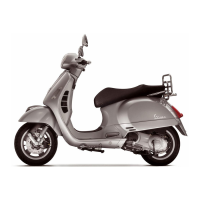
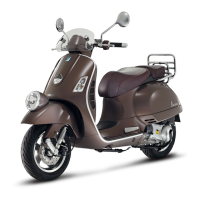
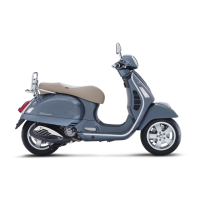
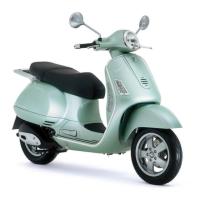
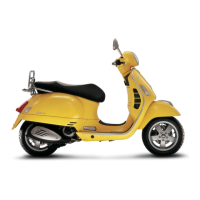
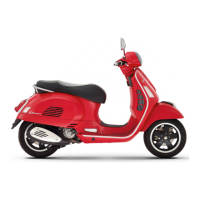
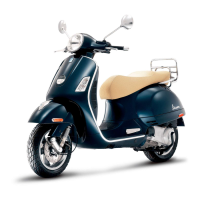
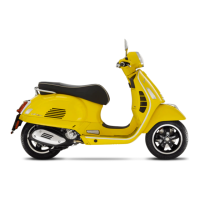
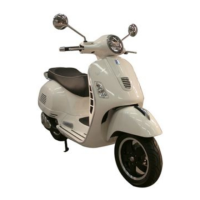
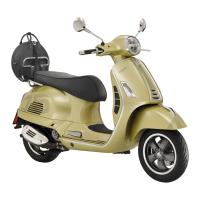


